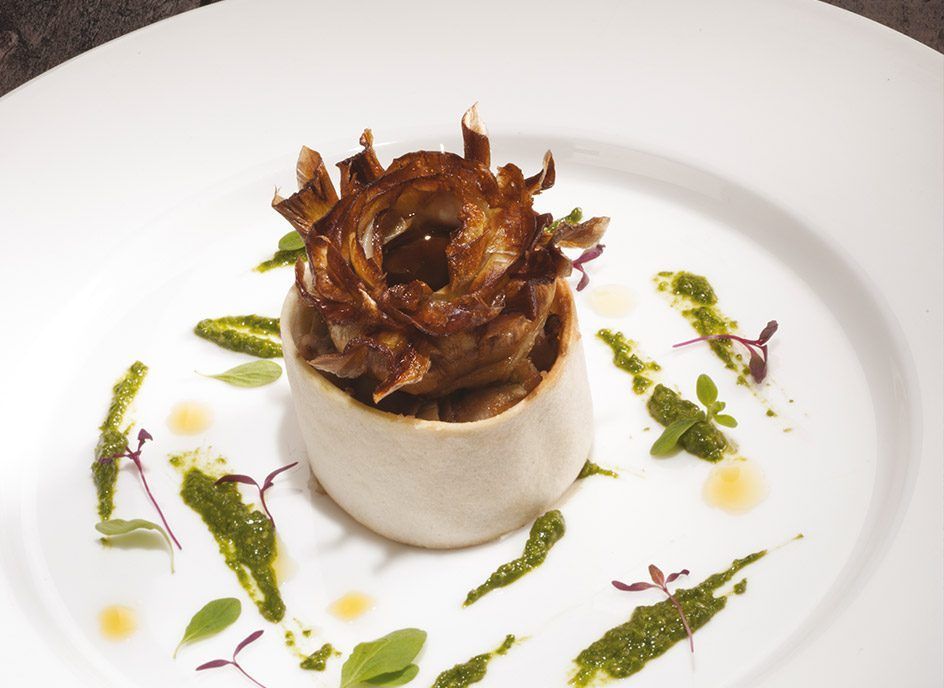
Main course
Artichoke tart with golden sweetbreads in white wine and basil & marjoram pesto.
Ingredients
Instructions
Trim the artichokes by removing leaves and spiny tufts from core, using a small scoop. Set aside in a bowl of cold water and lemon juice.
In a casserole dish, place the organic 100% Italian evo oil and garlic-flavored oil with unpeeled garlic cloves, bay leaf and a few sprigs of marjo- ram. Place 6 artichokes overtop, trimmed side down. Add salt and white wine, cover tightly and cook for 20/25 minutes. Let cool, slice the artichokes lengthwise and sauté them in a skillet, leave in pan to cool. Take the 10 remaining artichokes (trimmed and left whole) and boil them for 5 minutes in salted water with a little lemon juice. Let cool and then dry them well. Open the leaves like flower petals, dip them in flour and then fry them in sustainable 100% Italian evo oil until golden brown and crisp. Remove, let the oil drain off and keep warm.
For pesto: Place all the ingredients in a blender, then blend on high till well-mixed.
Strain resulting mixture and refrigerate.
To serve:
Brown lightly-floured sweetbreads in a skillet. Add to sau- teéd artichoke pan.
Pour some wine in the sweetbread skillet, add some beef stock and a little parsley and lemon juice and stir to make a fine sauce.
Make a diagonal stripe across the plates with the pesto, then place the ring of bread on the plate and fill the center with the artichokes and sautéed sweetbreads.
Top with the sauce and a slice of fried artichoke and serve.
Other recipes created by Claudio Sadler can be found in Giovanni Zucchi’s book Olive oil doesn’t grow on trees – The art of blending.
In a casserole dish, place the organic 100% Italian evo oil and garlic-flavored oil with unpeeled garlic cloves, bay leaf and a few sprigs of marjo- ram. Place 6 artichokes overtop, trimmed side down. Add salt and white wine, cover tightly and cook for 20/25 minutes. Let cool, slice the artichokes lengthwise and sauté them in a skillet, leave in pan to cool. Take the 10 remaining artichokes (trimmed and left whole) and boil them for 5 minutes in salted water with a little lemon juice. Let cool and then dry them well. Open the leaves like flower petals, dip them in flour and then fry them in sustainable 100% Italian evo oil until golden brown and crisp. Remove, let the oil drain off and keep warm.
For pesto: Place all the ingredients in a blender, then blend on high till well-mixed.
Strain resulting mixture and refrigerate.
To serve:
Brown lightly-floured sweetbreads in a skillet. Add to sau- teéd artichoke pan.
Pour some wine in the sweetbread skillet, add some beef stock and a little parsley and lemon juice and stir to make a fine sauce.
Make a diagonal stripe across the plates with the pesto, then place the ring of bread on the plate and fill the center with the artichokes and sautéed sweetbreads.
Top with the sauce and a slice of fried artichoke and serve.
Other recipes created by Claudio Sadler can be found in Giovanni Zucchi’s book Olive oil doesn’t grow on trees – The art of blending.

LO CHEF: CLAUDIO SADLER
“Evolving modern cuisine”: this is probably the definition that best describes his cooking philosophy. Milanese by birth and in spirit, born in 1956, Claudio Sadler is now an internationally recognised chef, awarded no less than 2 Michelin Stars.
In his recipes he is always looking for harmony, simplicity and delicacy, in a careful balance between faithfulness to the traditions of regional Italian cooking and reinterpretations enhanced by a very personal creativity and artistic sensibility. This is made possible thanks to an approach which is at the same time methodical and open to innovation, based on sound skills and a strict application of rules.
The process for developing a new Claudio Sadler dish is long and complex: often months are needed before a dish becomes part of the chef’s menu. But once there, each new creation shows off a small masterpiece in taste and presentation.
In his recipes he is always looking for harmony, simplicity and delicacy, in a careful balance between faithfulness to the traditions of regional Italian cooking and reinterpretations enhanced by a very personal creativity and artistic sensibility. This is made possible thanks to an approach which is at the same time methodical and open to innovation, based on sound skills and a strict application of rules.
The process for developing a new Claudio Sadler dish is long and complex: often months are needed before a dish becomes part of the chef’s menu. But once there, each new creation shows off a small masterpiece in taste and presentation.
